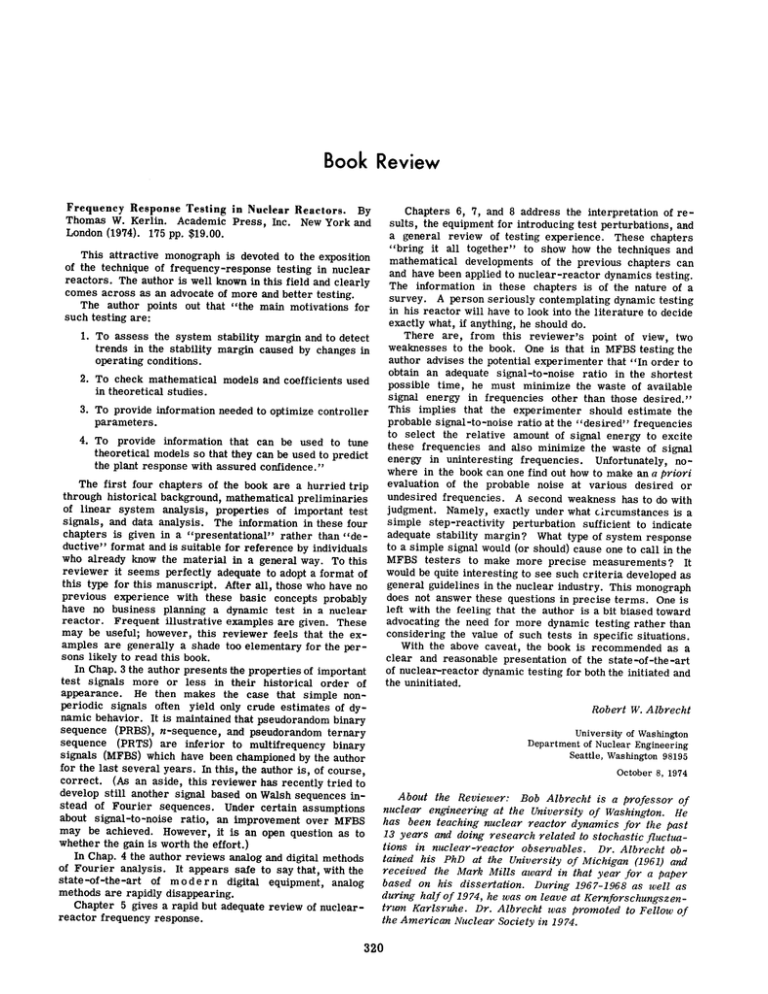Frequency Response Testing in Nuclear Reactors
advertisement

Book Review Frequency Response Testing in Nuclear Reactors. By Thomas W. Kerlin. Academic Press, Inc. New York and London (1974). 175 pp. $19.00. This attractive monograph is devoted to the exposition of the technique of frequency-response testing in nuclear reactors. The author is well known in this field and clearly comes across as an advocate of more and better testing. The author points out that "the main motivations for such testing are: 1. To assess the system stability margin and to detect trends in the stability margin caused by changes in operating conditions. 2. To check mathematical models and coefficients used in theoretical studies. 3. To provide information needed to optimize controller parameters. 4. To provide information that can be used to tune theoretical models so that they can be used to predict the plant response with assured confidence." The first four chapters of the book are a hurried trip through historical background, mathematical preliminaries of linear system analysis, properties of important test signals, and data analysis. The information in these four chapters is given in a "presentational" rather than "deductive" format and is suitable for reference by individuals who already know the material in a general way. To this reviewer it seems perfectly adequate to adopt a format of this type for this manuscript. After all, those who have no previous experience with these basic concepts probably have no business planning a dynamic test in a nuclear reactor. Frequent illustrative examples are given. These may be useful; however, this reviewer feels that the examples are generally a shade too elementary for the persons likely to read this book. In Chap. 3 the author presents the properties of important test signals more or less in their historical order of appearance. He then makes the case that simple nonperiodic signals often yield only crude estimates of dynamic behavior. It is maintained that pseudorandom binary sequence (PRBS), «-sequence, and pseudorandom ternary sequence (PRTS) are inferior to multifrequency binary signals (MFBS) which have been championed by the author for the last several years. In this, the author is, of course, correct. (As an aside, this reviewer has recently tried to develop still another signal based on Walsh sequences instead of Fourier sequences. Under certain assumptions about signal-to-noise ratio, an improvement over MFBS may be achieved. However, it is an open question as to whether the gain is worth the effort.) In Chap. 4 the author reviews analog and digital methods of Fourier analysis. It appears safe to say that, with the state-of-the-art of m o d e r n digital equipment, analog methods are rapidly disappearing. Chapter 5 gives a rapid but adequate review of nuclearreactor frequency response. Chapters 6, 7, and 8 address the interpretation of results, the equipment for introducing test perturbations, and a general review of testing experience. These chapters "bring it all together" to show how the techniques and mathematical developments of the previous chapters can and have been applied to nuclear-reactor dynamics testing. The information in these chapters is of the nature of a survey. A person seriously contemplating dynamic testing in his reactor will have to look into the literature to decide exactly what, if anything, he should do. There are, from this reviewer's point of view, two weaknesses to the book. One is that in MFBS testing the author advises the potential experimenter that "In order to obtain an adequate signal-to-noise ratio in the shortest possible time, he must minimize the waste of available signal energy in frequencies other than those desired." This implies that the experimenter should estimate the probable signal-to-noise ratio at the "desired" frequencies to select the relative amount of signal energy to excite these frequencies and also minimize the waste of signal energy in uninteresting frequencies. Unfortunately, nowhere in the book can one find out how to make an a priori evaluation of the probable noise at various desired or undesired frequencies. A second weakness has to do with judgment. Namely, exactly under what circumstances is a simple step-reactivity perturbation sufficient to indicate adequate stability margin? What type of system response to a simple signal would (or should) cause one to call in the MFBS testers to make more precise measurements? It would be quite interesting to see such criteria developed as general guidelines in the nuclear industry. This monograph does not answer these questions in precise terms. One is left with the feeling that the author is a bit biased toward advocating the need for more dynamic testing rather than considering the value of such tests in specific situations. With the above caveat, the book is recommended as a clear and reasonable presentation of the state-of-the-art of nuclear-reactor dynamic testing for both the initiated and the uninitiated. Robert W. Albrecht University of Washington Department of Nuclear Engineering Seattle, Washington 98195 October 8, 1974 About the Reviewer: Bob Albrecht is a professor of nuclear engineering at the University of Washington. He has been teaching nuclear reactor dynamics for the past 13 years and doing research related to stochastic fluctuations in nuclear-reactor observables. Dr. Albrecht obtained his PhD at the University of Michigan (1961) and received the Mark Mills award in that year for a paper based on his dissertation. During 1967-1968 as well as during half of 1974, he was on leave at Kernforschungszentrum Karlsruhe. Dr. Albrecht was promoted to Fellow of the American Nuclear Society in 1974.

